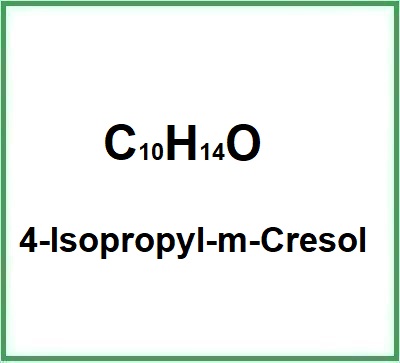Check the ingredients!
... live healthy!


![]() 4-Isopropyl-m-Cresol
4-Isopropyl-m-Cresol
Rating : 5
| Evaluation | N. Experts | Evaluation | N. Experts |
|---|---|---|---|
| 1 | 6 | ||
| 2 | 7 | ||
| 3 | 8 | ||
| 4 | 9 | ||
| 5 | 10 |
Pros:
Antimicrobial (1)10 pts from A_Partyns
| Sign up to vote this object, vote his reviews and to contribute to Tiiips.Evaluate | Where is this found? |
| "4-Isopropyl-m-Cresol, o-cymen-5-ol " about 4-Isopropyl-m-Cresol Review Consensus 10 by A_Partyns (12876 pt) | 2022-Oct-14 18:20 |
| Read the full Tiiip | (Send your comment) |
Compendium of the most significant studies with reference to properties, intake, effects.
Pizzey RL, Marquis RE, Bradshaw DJ. Antimicrobial effects of o-cymen-5-ol and zinc, alone & in combination in simple solutions and toothpaste formulations. Int Dent J. 2011 Aug;61 Suppl 3(Suppl 3):33-40. doi: 10.1111/j.1875-595X.2011.00047.x.
Abstract. Objectives: This study aimed to evaluate antimicrobial effects of an o-cymen-5-ol/zinc system. Methods: o-Cymen-5-ol and zinc gluconate minimum inhibitory concentration (MIC) and minimum bactericidal concentration (MBC) were determined against Streptococcus mutans, Actinomyces viscosus, Porphyromonas gingivalis, Fusobacterium nucleatum and Candida albicans. Synergy was investigated by checkerboard MIC/MBC; inhibition of P. gingivalis protease activity and S. mutans glycolysis were investigated. Slurried toothpastes containing the system were assessed in kill time assays against S. mutans and E. coli. Results: o-Cymen-5-ol MIC was between 1.7 mM to 3.4 mM; MBC was 3.4 mM to 6.7 mM. Zinc gluconate MIC was 2.8 mM to 11 mM; MBC was between 11 mM and >44 mM. The two agents in solution showed synergy (FICI≤0.50) against P. gingivalis and F. nucleatum, with MIC of 0.42 mM/0.69 mM for o-cymen-5-ol/zinc gluconate, respectively. Zinc inhibited glycolysis and protease to a greater degree than o-cymen-5-ol; glycolysis inhibition by the two agents was additive. o-Cymen-5-ol/zinc chloride in toothpaste showed greater effects than placebo (120s log10 kill=7.35±0.40 and 4.02±0.40, respectively). Conclusions: The zinc/o-cymen-5-ol system has direct antimicrobial effects and inhibits oral disease-related processes. Synergistic effects were seen against anaerobes. A system combining o-cymen-5-ol and zinc shows properties desirable for incorporation in toothpastes. © 2011 FDI World Dental Federation.
Otal, F. J. M., Sobrino, M. D., Cuadras, F. V., & Notario, I. Z. (2020). Eficacia frente al sangrado gingival de una pasta dental con o-cymen5-ol. Científica dental: Revista científica de formación continuada, 17(1), 41-48.
Abstract. Introduction: Gingivitis, if not treated, can cause irreversible periodontitis. One of the compounds used to fight it is o-cymen-5-ol. Objective: The main objective of this study was to demonstrate the clinical response of a toothpaste with o-cymen5-ol at 0.1% plus zinc, applied during 7 consecutive days at least twice a day, in patients with a bleeding rate of the gingival sulcus ≥ 25%. As a secondary objective, the tolerance of the product is evaluated. Methods: A prospective, randomised, double blind and controlled study, to evaluate the effectiveness of a toothpaste with o-cymen-5-ol compared to a toothpaste with triclosan at 0.3% plus zinc. After the baseline visit, the data were evaluated at 38 h, 48 h, 4 days and 7 days. Linear models of mixed effects were used, which were adjusted to the trial data in order to evaluate the response of the product in a study over time. Results: A total of 49 patients were included. The average baseline percentage in both groups was homogeneous. With respect to the start of the treatment, both groups experienced a significant reduction in the bleeding rate at 38 h. This continuous reduction increased significantly up to 67.5% and 71.8%, respectively, at 7 days from the start of the treatment. Conclusions: Toothpaste with o-cymen5-ol at 0.1% plus zinc improves the gingival bleeding rate significantly, with just 38 hours of application, in individuals with a baseline rate ≥ 25%, similarly to toothpaste with triclosan at 0.3% plus zinc.
Burnett GR, Stephen AS, Pizzey RL, Bradshaw DJ. In vitro effects of novel toothpaste actives on components of oral malodour. Int Dent J. 2011 Aug;61 Suppl 3(Suppl 3):67-73. doi: 10.1111/j.1875-595X.2011.00052.x.
Abstract. Objectives: To evaluate the efficacy of a novel toothpaste containing zinc ions and o-cymen-5-ol to reduce volatile sulfur compounds (VSCs) in in vitro models and to elucidate the mode of action for any activity observed. Methods: Three models were employed, a chemical neutralisation model to evaluate the chemical reactivity of toothpaste slurries to VSCs, a biofilm perfusion model to measure activity in an orally-relevant biofilm and a planktonic bacterial model to measure antimicrobial effects. Results: The models showed that zinc ions were able to react chemically with hydrogen sulfide to remove this odorous component of halitotic breath. This activity was confirmed within a complex biofilm model, with over 90% of hydrogen sulfide removed from perfusate gas by a slurry of the test toothpaste. Conclusions: This work provides a mode of action for the clinically observed reduction in VSCs seen for up to 12 hours post brushing with this novel toothpaste. © 2011 FDI World Dental Federation.
Yang J, Deol G, Myangar N. Retention of o-cymen-5-ol and zinc on reconstructed human gingival tissue from a toothpaste formulation. Int Dent J. 2011 Aug;61 Suppl 3(Suppl 3):41-5. doi: 10.1111/j.1875-595X.2011.00048.x.
Abstract. Objectives: To assess the retention of o-cymen-5-ol and zinc on reconstructed human gingival tissue delivered by topical applications of toothpaste formulated with 0.1%w/w o-cymen-5-ol and 0.6%w/w zinc chloride (ZnCl2). Methods: EpiGingival tissues were treated topically for 2 minutes with either solutions or toothpaste slurries containing o-cymen-5-ol and ZnCl2. Tissues were rinsed with water between application and the effects of repeat dosing for up to 6 occasions were investigated. Tissues were blot dried, extracted and o-cymen-5-ol and zinc were measured by HPLC and atomic absorption spectroscopy, respectively. Results: Retention of o-cymen-5-ol and zinc delivered from solutions to EpiGingival tissues showed a dose response to the concentration and to the number of applications. Significantly higher concentrations of zinc were delivered to EpiGingival tissues by toothpaste compared to equivalent doses delivered from solution. Equivalent doses of o-cymen-5-ol were delivered from toothpaste and solution. No cytotoxic effects on the EpiGingival tissues, measured by MTT viability, were detected following application of test toothpaste compared to a water control. Conclusions: Reconstructed human gingival tissue proved to be an effective model for the assessment of active retention from topically applied formulations. The test toothpaste was effective in delivering o-cymen-5-ol and zinc to oral soft tissue in vitro. © 2011 FDI World Dental Federation.
| Sign up to vote this object, vote his reviews and to contribute to Tiiips.EvaluateClose | (0 comments) |
| "Descrizione" about 4-Isopropyl-m-Cresol Review Consensus 10 by A_Partyns (12876 pt) | 2023-Jun-26 15:43 |
| Read the full Tiiip | (Send your comment) |
4-Isopropyl-m-Cresol is a chemical compound, phenol, is a natural monoterpenoid phenol derived from cimene and isomeric with carvacrol, which is found in thyme oil and is an analogue of thymol, more known by the name o-cymen-5-ol, or as 4-Isopropyl-3-Methylphenol, an iso-Isopropyl cresol typically used as a preservative for its antiseptic properties.
The name defines the structure of the molecule:
The synthesis process takes place in several stages:
It appears as a white powder or white crystals, odourless .

What it is used for and where
Dentistry
It is a component placed on the market in 2009-2010. It is used in toothpastes usually accompanied by zinc chloride to maintain gingival health as a biocide, preservative and fragrance ingredient.
Cosmetics
4-Isopropyl-m-Cresol is a restricted ingredient as V / 38 a Relevant Item in the Annexes of the European Cosmetics Regulation 1223/2009.
o-cymen-5-ol is used in shampoos as a preservative, antiseptic, biocide.
Safety
The Cosmetic Ingredients Revue Panel considered the available data to be insufficient to support the safety of this ingredient in cosmetics and believes that studies are needed to demonstrate the absence of chemical leucoderma at use concentrations of p-cresol and mixed cresols, or to demonstrate a dose response from which a safe concentration could be derived (1), while other more recent studies support its safety at low levels (0.1%) in toothpaste (2).
For more information:
Typical commercial product characteristics 4-Isopropyl-3-Methylphenol
| Appearance | White powder |
| pH | 6.5~7.0 |
| Boiling Point | 233.8±9.0°C at 760 mmHg |
| Melting Point | 111-114°C |
| Flash Point | 104.1±7.2°C |
| Density | 1.0±0.1 g/cm3 |
| Vapor Pressure | 0.0±0.5 mmHg at 25°C |
| PSA | 20.23000 |
| LogP | 3.28 |
| Refraction Index | 1.523 |
| Water | ≤0.2% |
| Residue on ignition | ≤0.1% |
| UV-vis wavelength | 211,270nm |
| Total impurity | ≤1.0% |
| Each impurity | ≤0.5% |
| Chemical Safety | 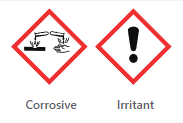 |
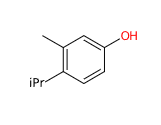 | 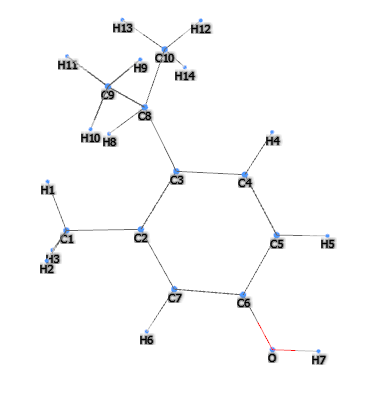 |
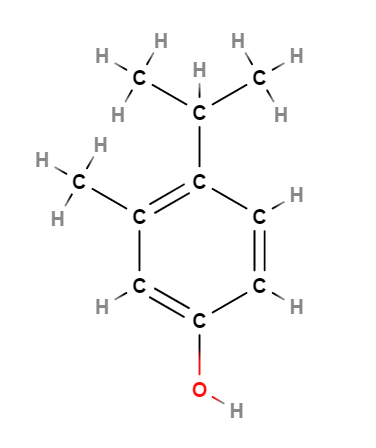 | 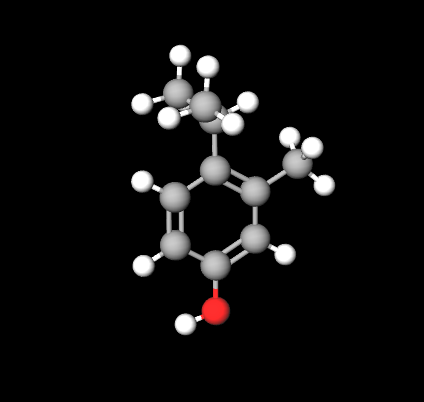 |
Synonyms:
References___________________________________________________________________
(1) Andersen A. Final report on the safety assessment of sodium p-chloro-m-cresol, p-chloro-m-cresol, chlorothymol, mixed cresols, m-cresol, o-cresol, p-cresol, isopropyl cresols, thymol, o-cymen-5-ol, and carvacrol. Int J Toxicol. 2006;25 Suppl 1:29-127. doi: 10.1080/10915810600716653.
(2) Kakar A, Newby EE, Ghosh S, Butler A, Bosma ML. A randomised clinical trial to assess maintenance of gingival health by a novel gel to foam dentifrice containing 0.1%w/w o-cymen-5-ol, 0.6%w/w zinc chloride. Int Dent J. 2011 Aug;61 Suppl 3(Suppl 3):21-7. doi: 10.1111/j.1875-595X.2011.00045.x.
--
A randomised clinical trial to assess maintenance of gingival health by a novel dentifrice containing 0.1%w/w o-cymen-5-ol and 0.6%w/w zinc chloride.Protection against enamel demineralisation using toothpastes containing o-cymen-5-ol, zinc chloride and sodium fluoride.
Churchley D, Newby CS, Willson R, Haider A, Schemehorn B, Lynch RJ.
Int Dent J. 2011 Aug;61 Suppl 3:55-9. doi: 10.1111/j.1875-595X.2011.00050.x.
Kakar A, Newby EE, Kakar K, Ghosh S, Targett D, Bosma ML.
Int Dent J. 2011 Aug;61 Suppl 3:13-20. doi: 10.1111/j.1875-595X.2011.00044.x
Antimicrobial effects of o-cymen-5-ol and zinc, alone & in combination in simple solutions and toothpaste formulations.
Pizzey RL, Marquis RE, Bradshaw DJ.
Int Dent J. 2011 Aug;61 Suppl 3:33-40. doi: 10.1111/j.1875-595X.2011.00047.x.
Benefits of a silica-based fluoride toothpaste containing o-cymen-5-ol, zinc chloride and sodium fluoride.
Newby CS, Rowland JL, Lynch RJ, Bradshaw DJ, Whitworth D, Bosma ML.
Int Dent J. 2011 Aug;61 Suppl 3:74-80. doi: 10.1111/j.1875-595X.2011.00053.x.
| Sign up to vote this object, vote his reviews and to contribute to Tiiips.EvaluateClose | (0 comments) |
Read other Tiiips about this object in __Italiano (2)
Component type: Chemical Main substances: Last update: 2018-08-04 13:04:35 | Chemical Risk: |

